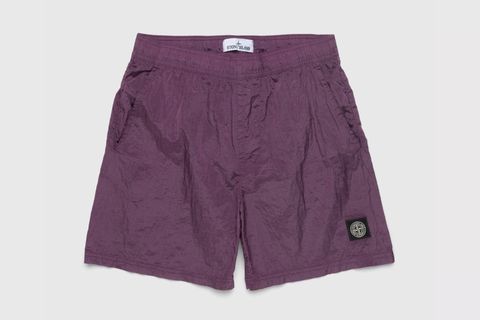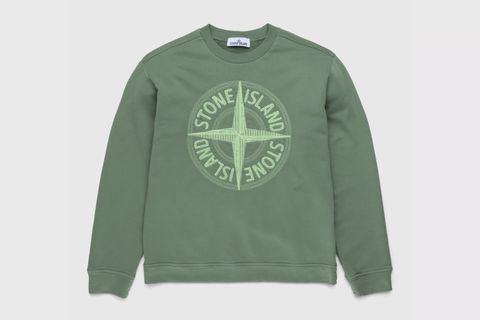Here's How to Spot Fake Stone Island
Thanks to the efforts of a Mr A. Graham, Stone Island is generating all sorts of hype over in the USA. Rappers and streetwear heads getting into the iconic Italian label big time, so much so that Drake got a ridiculous $100k diamond-encrusted Stone Island chain made for him by celebrity jeweler Ben Baller. There's even been some hilarious e-beef between A$AP Nast and Travis Scott on who got into the brand first.
While the brand may be a new addition to the American streetwear landscape, it's been a permanent fixture in Europe since it was founded in the ’80s. All over the continent, you'll find hardcore Stone Island fans, and the brand has a long and illustrious history in European street style — particularly in the terrace casual scene. As Supreme can tell you, one unfortunate side-effect to immense popularity is an immense amount of counterfeits being made in your name.
Just recently, we've highlighted some of the fake gear that can be found in places as far removed as Jamaica, Nigeria and Moscow. Now, we're turning our gaze to the murky world of online shopping — particularly the second-hand market — where it's not quite so clear whether the object of your desire is legit or not. There's a lot of phony gear out there being sold, often at highly suspicious prices. Basically, cheap Stone Island = fake Stone Island.
We linked with a couple of hardcore fans of Stone Island (or "Stoney" as it's affectionately known in the UK) to get the low-down on how much counterfeit gear is out there, and how to spot a fake when you see it.
Ollie Evans founded Too Hot Limited, a showroom that sells rare pieces from brands popular in the ’90s casual and rave scenes — think FILA, Iceberg, Napapijri, Prada and Moschino. Stoney plays a big part in Too Hot's curation.
Lyle Cross runs Garm Shack, a wide-ranging seller of vintage gear from brands like Tommy Hilfiger, Polo, Champion, Nike and the like. Plus plenty of Stone Island, of course.
The Low-Down
Ollie Evans, Too Hot Limited: "There's a lot of fake Stone Island out there, from all eras — all the way back to the ’80s. In the UK one of the most common fakes is the 'Raso Tomato,' a copy of a genuine jacket from around 2004 which used a Stone Island technology called Raso Gommato — a rubberized coating applied to the lining of a jacket. These fakes never had a rubberized lining, but they had the Raso Gommato branding.
Whoever made this jacket must have manufactured thousands and thousands of them, as you still see so many of them around — I’ve seen people who really should know better wearing them."
Lyle Cross, Garm Shack: "There's loads of fakes! Mainly spread about on eBay, Facebook marketplaces, Depop, and street markets...that kinda thing. The most commonly faked items are Raso Gommato jackets, Micro Reps jackets, tracksuits (normally those have two badges — which is a dead giveaway), polo tops and tees."
Check the Buttons
Ollie: "There are few ways you can look out for fakes, I tend to find looking at the buttons is the easiest. All the sleeve buttons on Stone Island jackets made after 1986 have a cross in the centre of them, as opposed to four holes which you see on a lot of the older fakes.
Nowadays the counterfeiters have cottoned-on to the button detail, so look at the back of the buttons — if it’s legit there will be a small indent which they often miss off."
...and the Label
Ollie: "You can also look at the labels, but sometimes that can be less conclusive. A lot of people think if it’s got an art number on the label it’s legit but this is definitely not the case. Fakers have been replicating art numbers for years. What you can look out for is the country of origin, which should be Italy, Romania, or in some cases Tunisia. More often than not the fakes pieces do not have a country of origin at all."
Lyle: "Check the Art number on the wash label, unless it’s a proper vintage piece (before 1986). See my blog for more on art numbers as there is a lot on the Art no. Plus it is one of the best things to use to spot fakes if you are unsure. The majority of fakes will have 222 at the end of the art number."
Note: Stone Island has added a scannable QR code to the labels of newer garments: more on that later.
The Stone Island Badge Is Key
Ollie: "You can also spot fakes badges quite easily, when you know what to look for. Every genuine Stone Island badge, except those from 1982-4, features a single drop stitch from the button eyelid down to the border."
Lyle: "Nine times out of 10, a fake Stone Island badge will look off color wise, look out of proportion, stitching off, and like card, it looks that hard. Remember to keep in mind that there are numerous types of badges as well, the normal Stone Island badge, Ghost badge etc. and a vintage Stone Island badge will have a green edge. Also look out for double badges — anything with two badges is going to be fake..always!"
Cheap Stone Island is Fake Stone Island
Ollie: "Apart from the small details that will tell you one way or the other, just look out for quality and price. Stone Island is a premium brand that has always used progressive and innovative materials, which means it's expensive. If you see a BNWT (brand new with tags) jacket advertised for £100 it’s not going to be real. New Stone Island jackets starts at £350+, so if it looks too good to be true, it probably is."
Look out for the Zips
Lyle: "The zips will always be manufactured by a reputable brand such as YKK or Lampo or feature the brands name and logo printed on them. However, this is not always the case, but when looking at the zips, you will want to see if they look and feel of a higher quality as they are made to last, so will never be flimsy."
Be Careful on eBay
Ollie: "eBay is full of fake Stone Island jackets, there are also counterfeit websites that look like the real thing, but are actually selling fakes. Your best bet is to stick to the official website and dealer network, or buy from a vintage specialist such as ourselves — we have years of experience dealing with the product."
Lyle: "On eBay, it comes down to a few things: seller rating, price, type of item. eBay has a huge amount of fake Stone Island. Some sellers have high ratings and appear to be selling cheap Stone Island pieces that are new, even though they are fake…and really bad fakes at that. So it's best to follow the things to look out for mentioned above. If you know how to spot fakes, then you'll be fine."
Try Depop and Facebook
Lyle: "Depop and Facebook have plenty of cheap Stone Island items, as they're full of second-hand clothing. However you run the risk of not being 100 percent on what you’re buying unless you know how to spot fakes. Facebook marketplace is full of fakes, so don’t ever bother with that.
However, there are a ton of Facebook groups that are great for buying items — like Stone Island Talk UK/EU — I have brought a lot of my personal collection from these kinda groups. If anything is fake, members will point it out as they don’t want any fakes on the page."
Appearances Can Be Deceiving
Lyle: "If you are looking to buy items new, then your best bet is to stick to the legit stockist or Stone Island stores. It is hard to pinpoint exact sites to watch out for, but appearance plays a big part, alongside the pricing.
The price is the main thing to look out for, as they sell items 65 percent off the retail price. They also have items that don’t even exist. Then looking at the site, all the photos are mismatched, it's cheaply made, and the site itself is badly designed.
Stone Island is an expensive brand, so as mentioned prior, price is the biggest giveaway on new items' legitimacy. Stone Island have made a big thing on cracking down on fake dealers — there's more info here on the official brand website."
The Stone Island Authenticity Program
Stoney has an in-house program to help combat fakes. All garments produced from SS14 onwards use Certilogo technology to verify their authenticity — just simply scan the QR code or product number on each garment's label using your phone.
Here's what the brand has to say on the subject of counterfeits:
"Stone Island is aware of the existence of websites selling fake products.
Some even reproduce the brand's trademark and are therefore particularly misleading for consumers. These sites are often registered with a domain comprising the brand name Stone Island, or something similar, and additional words such as ‘jackets’, ‘outlet’ or ‘official’.
It is our priority to defend and protect our consumers and our brand image. This is why we have taken every possible action against the sale of fake products and shut down misleading sites, web pages and social network pages through legal action using three international companies specializing in the fight against counterfeiting: NetNames, MarkMonitor and React.
Those who have ordered or purchased a fake garment can go to their local authority and contact their bank to, where possible, block payment made to a suspected fraudulent site."
More info can be found at the Stone Island official website.
New to Stoney? Here's everything you need to know about the legendary Italian brand.








